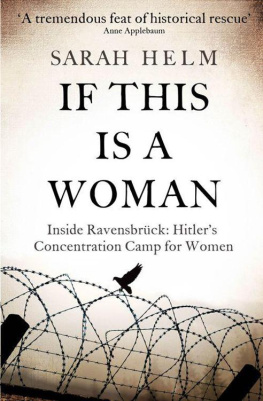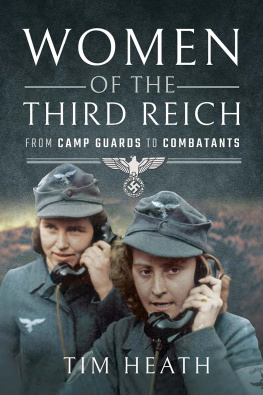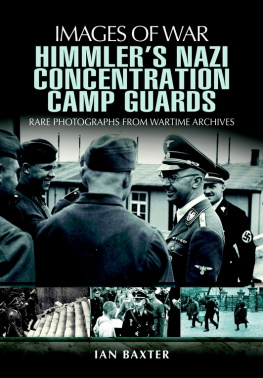A Life in Secrets
Published by Little, Brown
ISBN: 978-0-7481-1243-2
Copyright 2015 Sarah Helm
The moral right of the author has been asserted.
All rights reserved. No part of this publication may be reproduced, stored in a retrieval system, or transmitted, in any form or by any means, without the prior permission in writing of the publisher.
The publisher is not responsible for websites (or their content) that are not owned by the publisher.
Little, Brown
Little, Brown Book Group
100 Victoria Embankment
London, EC4Y 0DY
www.littlebrown.co.uk
www.hachette.co.uk
To those who refused
Consider if this is a woman,
Without hair and without name
With no more strength to remember,
Her eyes empty and her womb cold
Like a frog in winter.
Meditate that this came about:
I commend these words to you.
Primo Levi, If This is a Man
Contents
F rom Berlins Tegel airport it takes just over an hour to reach Ravensbrck. The first time I drove there, in February 2006, heavy snow was falling and a lorry had jack-knifed on the Berlin ring road, so it would take longer.
Heinrich Himmler often drove out to Ravensbrck, even in atrocious weather like this. The head of the SS had friends in the area and would drop in to inspect the camp as he passed by. He rarely left without issuing new orders. Once he ordered more root vegetables to be put in the prisoners soup. On another occasion he said the killing wasnt going fast enough.
Ravensbrck was the only Nazi concentration camp built for women. The camp took its name from the small village that adjoins the town of Frstenberg and lies about fifty miles due north of Berlin, off the road to Rostock on Germanys Baltic coast. Women arriving in the night sometimes thought they were near the coast because they tasted salt on the wind; they also felt sand underfoot. When daylight came they saw that the camp was built on the edge of a lake and surrounded by forest. Himmler liked his camps to be in areas of natural beauty, and preferably hidden from view. Today the camp is still hidden from view; the horrific crimes enacted there and the courage of the victims are largely unknown.
Ravensbrck opened in May 1939, just under four months before the outbreak of war, and was liberated by the Russians six years later it was one of the very last camps to be reached by the Allies. In the first year there were fewer than 2000 prisoners, almost all of whom were Germans. Many had been arrested because they opposed Hitler communists, for example, and Jehovahs Witnesses, who called Hitler the Antichrist. Others were rounded up simply because the Nazis considered them inferior beings and wanted them removed from society: prostitutes, criminals, down-and-outs and Gypsies. Later, the camp took in thousands of women captured in countries occupied by the Nazis, many of whom had been in the resistance. Children were brought there too. A small proportion of the prisoners about 10 per cent were Jewish, but the camp was not formally designated a camp for Jews.
At its height, Ravensbrck had a population of about 45,000 women; over the six years of its existence around 130,000 women passed through its gates, to be beaten, starved, worked to death, poisoned, executed and gassed. Estimates of the final death toll have ranged from about 30,000 to 90,000; the real figure probably lies somewhere in between, but so few SS documents on the camp survive nobody will ever know for sure. The wholesale destruction of evidence at Ravensbrck is another reason the camps story has remained obscured. In the final days, every prisoners file was burned in the crematorium or on bonfires, along with the bodies. The ashes were thrown in the lake.
I first learned of Ravensbrck when writing an earlier book about Vera Atkins, a wartime officer with the British secret services Special Operations Executive. Immediately after the war Vera launched a single-handed search for British SOE women who had been parachuted into occupied France to help the resistance, many of whom had gone missing. Vera followed their trails and discovered that several had been captured and taken to concentration camps.
I tried to reconstruct her search, and began with her personal papers, which were filed in brown cardboard boxes and kept by her sister-in-law Phoebe Atkins at her home in Cornwall. The word Ravensbrck was written on one of the boxes. Inside were handwritten notes from interviews with survivors and with SS suspects some of the earliest evidence gathered about the camp. I flicked through the papers. We had to strip naked and were shaved, one woman told Vera. There was a column of choking blue smoke.
A survivor talked of a camp hospital where syphilis germs were injected into the spinal cord. Another described seeing women arrive at the camp after a death march through the snow from Auschwitz. One of the male SOE agents, imprisoned at Dachau, wrote a note saying he had heard about women from Ravensbrck being forced to work in a Dachau brothel.
Several of the interviewees mentioned a young woman guard called Binz who had light, bobbed hair. Another guard had once been a nanny in Wimbledon. Among the prisoners were the cream of Europes women, according to a British investigator; they included General de Gaulles niece, a former British womens golf champion and scores of Polish countesses.
I began to look for dates of birth and addresses in case any of the survivors or even the guards might still be alive. Someone had given Vera the address of a Mrs Chatenay, who knows about the sterilisation of children in Block 11. A Doctor Louise Le Porz had made a very detailed statement saying the camp was built on an estate belonging to Himmler and his private Schloss, or chteau, was near by. Her address was Mrignac, Gironde, but from her date of birth she was probably dead. A Guernsey woman called Julia Barry lived in Nettlebed in Oxfordshire. Other addresses were impossibly vague. A Russian survivor was thought to be working at the mother and baby unit, Leningrad railway station.
Towards the back of the box I found handwritten lists of prisoners, smuggled out by a Polish woman who had taken notes in the camp as well as sketches and maps. The Poles had all the best information, the note said. The woman who wrote the list turned out to be long dead, but some of the addresses were in London, and the survivors still living.
I took the sketches with me on the first drive out to Ravensbrck, hoping they would help me find my way around when I got there. But as the snow thickened I wondered if Id reach the camp at all.
Many tried and failed to reach Ravensbrck. Red Cross officials trying to get to the camp in the chaos of the final days of war had to turn back, such was the flow of refugees moving the other way. A few months after the war, when Vera Atkins drove out this way to start her investigation, she was stopped at a Russian checkpoint; the camp was inside the Russian zone of occupation and access by other Allied nationals was restricted. By this time, Veras hunt for the missing women had become part of a bigger British investigation into the camp, resulting in the first Ravensbrck war crimes trials, which opened in Hamburg in 1946.
In the 1950s, as the Cold War began, Ravensbrck fell behind the Iron Curtain, which split survivors east from west and broke the history of the camp in two.
Out of view of the West, the site became a shrine to the camps communist heroines, and all over East Germany streets and schools were named after them.
Meanwhile, in the West, Ravensbrck literally disappeared from view. Western survivors, historians, journalists couldnt even get near the site. In their own countries the former prisoners struggled to get their stories published. Evidence was hard to access. Transcripts of the Hamburg trials were classified secret and closed for thirty years.













